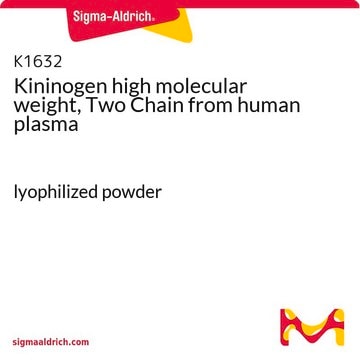K2638
Kallikrein from human plasma
buffered aqueous solution, ≥5 units/mg protein
Synonym(s):
Kininogenase, Kininogenin
About This Item
Recommended Products
form
buffered aqueous solution
Quality Level
specific activity
≥5 units/mg protein
UniProt accession no.
shipped in
dry ice
storage temp.
−20°C
Gene Information
human ... KLK1(3816)
Looking for similar products? Visit Product Comparison Guide
General description
Application
- to culture human hepatocellular carcinoma cell line
- to study its effects on the cleavage of Neisserial heparin binding antigen (NHBA) from Neisseria meningitidis
- in peptidase inhibition assay
Biochem/physiol Actions
Unit Definition
Physical form
Storage Class
12 - Non Combustible Liquids
wgk_germany
WGK 1
flash_point_f
Not applicable
flash_point_c
Not applicable
ppe
Eyeshields, Gloves, multi-purpose combination respirator cartridge (US)
Certificates of Analysis (COA)
Search for Certificates of Analysis (COA) by entering the products Lot/Batch Number. Lot and Batch Numbers can be found on a product’s label following the words ‘Lot’ or ‘Batch’.
Already Own This Product?
Find documentation for the products that you have recently purchased in the Document Library.
Customers Also Viewed
Our team of scientists has experience in all areas of research including Life Science, Material Science, Chemical Synthesis, Chromatography, Analytical and many others.
Contact Technical Service












